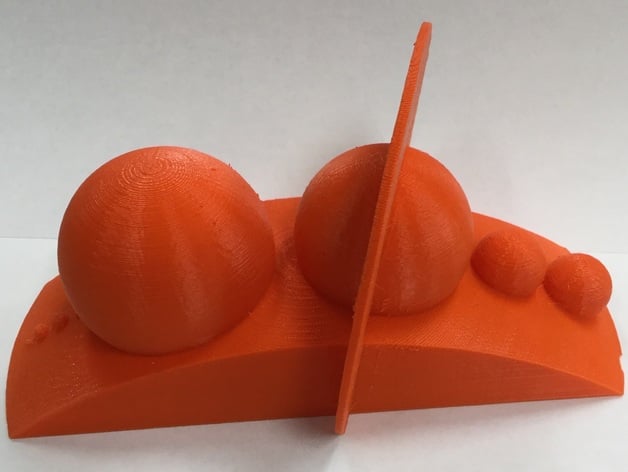
Modeling the Solar System
thingiverse
In this engaging lesson, students will learn how to showcase the solar system on a massive scale using innovative 3D design and printing techniques. Print Settings Printer Brand: MakerBot Printer: MakerBot Replicator (5th Generation) Rafts: Yes Supports: No Resolution: .2mm Infill: 10% Notes: I always use rafts, but they probably weren't necessary in this case. How I Designed This This print was discovered on Thingiverse.com and is used as an example of how one can display planets to scale. I printed it exactly as it was, then modified the .stl to show the names of the planets. Standards CCSS Overview and Background This project originated from a Summer School theme at my school. Every summer we study space, and I thought it would be fantastic to 3D print a solar system. It was surprisingly difficult to find systems already made that would give accurate dimensions. Students will learn about the proportions of the solar system and have to decide how they want to portray them. The one shown has the smaller planets quite small in order to fit the model. The question to ask is, "How can we stay within the boundaries of the printer, but still create an accurate model?" Objectives Students will learn about the sizes of the planets in our solar system and develop a way to display the planets to scale using 3D design and printing. Audience Grades 9-12 Subjects Science (Earth Science, Physical Science) Math (proportions) Art (3D design) Skills Learned (Standards) ESS1: Earth’s Place in the Universe HS-ESS1-4. Use mathematical or computational representations to predict the motion of orbiting objects in the solar system. ESS1.B: Earth and the Solar System Kepler’s laws describe common features of the motions of orbiting objects, including their elliptical paths around the sun. Orbits may change due to the gravitational effects from, or collisions with, other objects in the solar system. (HS-ESS1-4) CCSS.MATH.CONTENT.HSN.Q.A.2 Define appropriate quantities for the purpose of descriptive modeling. CCSS.MATH.CONTENT.HSN.Q.A.3 Choose a level of accuracy appropriate to limitations on measurement when reporting quantities. Lesson Plan and Activity Students will be introduced to the size of the planets. If possible, the instructor should have visual aids to demonstrate the proportional relationships (basketball vs golf ball vs grain of sand, etc). Students will then brainstorm ways to display the planets with accurate size (Note that if the sun is included in the model, the rest of the planets will have to be tiny. If the sun is left out of the design, you may be able to get a visible display). Once the students have formulated a plan, they will use 3D design software (like Tinkercad) to design printable models to create their display. Materials Needed Student groups will each need a computer with design software. Students will need a reference sheet with planet sizes listed (attached) Skills Learned ESS1 HS-ESS1-4 ESS1.B Duration of Lesson The design of the planets could take up to a week of class time, and printing would be an additional time depending on printer capacity, size of models, and speed of the printer. Rubric and Assessment Models can be graded on proportional accuracy, creativity/originality of the display, and quality of the model after it is constructed. Handouts & Assets The planet information list is attached in "files." References https://solarsystem.nasa.gov/docs/modelingsolarsystem_20070112.pdf
With this file you will be able to print Modeling the Solar System with your 3D printer. Click on the button and save the file on your computer to work, edit or customize your design. You can also find more 3D designs for printers on Modeling the Solar System.
